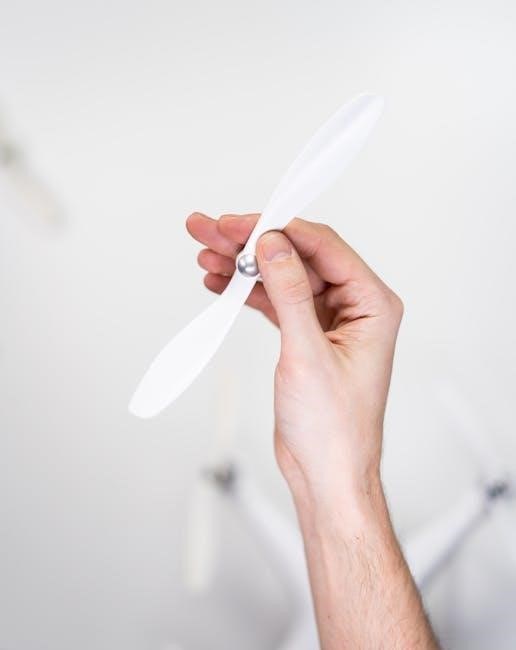mercruiser alpha one propeller guide

The Mercruiser Alpha One Outdrive is a reliable stern drive system designed for boats with 120-300 HP engines, offering durability, smooth operation, and enhanced fuel efficiency for optimal boating performance.
1.1 Features and Benefits
The Mercruiser Alpha One Outdrive offers exceptional durability, smooth operation, and enhanced fuel efficiency. Its robust design supports various propeller options, ensuring optimal performance for different boating needs. Key benefits include reduced vibration, quieter operation, and improved handling. The system’s compatibility with multiple engine sizes makes it versatile, while its ease of maintenance enhances overall ownership experience. These features make it a preferred choice for boaters seeking reliability and performance.
1.2 Importance of Propeller Selection
Proper propeller selection is critical for maximizing the performance of your Mercruiser Alpha One Outdrive. The right propeller ensures optimal RPM, speed, and fuel efficiency, while the wrong one can lead to poor performance, reduced efficiency, and increased wear on the engine. Matching the propeller to your boat’s specific needs, including its size, weight, and intended use, is essential for achieving the best results. This step directly impacts your boating experience and the longevity of your system.

Understanding Propeller Basics
A boat propeller converts engine power into thrust, enabling movement through water. It consists of blades attached to a hub, spinning to create forward or reverse motion. Key factors like diameter, pitch, number of blades, and material type influence performance. Understanding these basics helps optimize speed, efficiency, and overall boating experience. Proper blade design ensures effective water displacement, while material choices like aluminum or stainless steel impact durability and cost.
2.1 Diameter and Pitch Explained
The diameter of a propeller is the distance across the circle traced by the blades, while pitch is the theoretical forward distance the propeller moves through the water with one full rotation. A larger diameter increases thrust but may reduce RPM, while a higher pitch improves speed at higher RPM but can sacrifice low-end torque. Balancing these factors ensures optimal performance for your boat’s specific needs. Proper alignment of diameter and pitch is crucial for maximizing efficiency and power.
2.2 Number of Blades and Material Types
The number of blades on a propeller impacts performance, with 3-blade props typically offering better top-end speed and 4-blade props providing improved stability and hole-shot. Materials like aluminum are cost-effective and suitable for smaller boats, while stainless steel props are more durable and ideal for high-performance applications. Each configuration and material type is tailored to specific boating needs, ensuring optimal efficiency and longevity. Choosing the right combination enhances overall boat performance and handling.

Key Considerations for Propeller Selection
When selecting a propeller for the Mercruiser Alpha One, consider factors like horsepower, gear ratio, and whether your model is Generation I or II. These elements ensure optimal performance and compatibility with your boat’s specifications.
3.1 Horsepower and Engine Specifications
The Mercruiser Alpha One supports engines ranging from 120 to 300 horsepower, making it essential to match the propeller to your engine’s specific power output. Engine displacement, fuel type (carbureted or EFI), and maximum RPM also play critical roles in selecting the right propeller. For example, a higher horsepower engine may require a lower pitch propeller to stay within the optimal RPM range. Always refer to your engine’s specifications and consider water testing to ensure the best performance.
3.2 Gear Ratio and Its Impact
The gear ratio of your Mercruiser Alpha One outdrive significantly impacts propeller performance. A lower gear ratio increases RPM, which is ideal for high-speed applications or lighter boats. Conversely, a higher gear ratio reduces RPM but enhances torque, making it suitable for heavy loads or cruising. Properly matching the propeller pitch to your gear ratio ensures optimal engine performance, fuel efficiency, and boat handling. Always consider your boating needs and engine specifications when selecting the right combination.
3.3 Generation I vs. Generation II Differences
The Generation I and Generation II Mercruiser Alpha One outdrives differ in design and performance. Generation I, introduced earlier, features a straightforward gear system and is compatible with a wide range of propellers. Generation II, an upgraded version, offers improved corrosion resistance, enhanced gear ratios, and better overall durability. Understanding these differences is crucial for selecting the right propeller, as each generation has specific compatibility requirements and performance characteristics. Proper matching ensures optimal boat efficiency and engine functionality.

Selecting the Right Propeller Size
Choosing the correct propeller size for your Mercruiser Alpha One involves measuring diameter and pitch to ensure optimal performance, efficiency, and engine RPM alignment.
4.1 How to Measure and Choose Diameter
To determine the appropriate propeller diameter for your Mercruiser Alpha One, begin by measuring the existing propeller from tip to tip. Ensure your outdrive generation (I or II) and engine specifications align with the diameter. Typically, diameters range between 13 to 15 inches, depending on horsepower and application. A larger diameter can enhance torque but may lower RPM, while a smaller diameter increases RPM but reduces torque. Always consult the manufacturer’s guidelines or use a propeller selection tool for precise sizing.
4.2 Pitch Selection for Optimal Performance
The pitch of a propeller determines its performance efficiency. A higher pitch increases top speed but may reduce RPM, while a lower pitch enhances acceleration and improves low-end torque. For the Mercruiser Alpha One, start with the manufacturer’s recommended pitch range based on your engine’s horsepower and gear ratio. Test different pitches to find the optimal balance between speed and engine RPM, ensuring it stays within the recommended range for your specific setup. Proper pitch selection ensures maximum performance and fuel efficiency.

Types of Propellers for Mercruiser Alpha One
The Mercruiser Alpha One supports various propeller types, including aluminum and stainless steel, as well as 3-blade and 4-blade configurations, each offering unique performance benefits for different boating needs.
5.1 Aluminum vs. Stainless Steel Props
Aluminum props are lightweight, cost-effective, and ideal for smaller boats, offering good performance at lower speeds. Stainless steel props are durable, resistant to corrosion, and provide superior performance in rough conditions, though they are heavier and more expensive. Aluminum props are often preferred for budget-conscious owners, while stainless steel props are chosen for their longevity and enhanced efficiency in demanding marine environments. Each material suits different boating needs and preferences.
5.2 3-Blade vs. 4-Blade Props
3-blade props are ideal for speed and efficiency, providing quicker acceleration and top-end performance, making them suitable for smaller boats and racing applications. 4-blade props, on the other hand, offer better control, stability, and traction, reducing vibration and cavitation; They are often preferred for larger boats, heavy loads, or when towing. The choice between them depends on the boat’s size, intended use, and engine specifications to maximize performance and handling.

Tools and Equipment Needed
Essential tools include a wrench, socket set, and a propeller puller. Safety gear like gloves and goggles is crucial, along with proper ventilation to prevent accidents during installation or maintenance.
6.1 Essential Tools for Installation
Essential tools for installing the Mercruiser Alpha One propeller include a propeller wrench, socket set, and a torque wrench for secure bolt tightening. A propeller puller may be needed if the propeller is stuck; Safety gear such as gloves and goggles is crucial. Ensure you have a hub key for proper alignment and installation. Always refer to the manufacturer’s instructions for specific tool requirements to ensure a safe and effective installation process.
6.2 Safety Precautions and Gear
When working with the Mercruiser Alpha One propeller, wear protective gloves and safety goggles to prevent injuries. Ensure the boat is in a well-ventilated area and the engine is turned off. Disconnect the battery to avoid accidental startups. Use jack stands or blocking to stabilize the boat. Keep a fire extinguisher nearby. Always follow manufacturer guidelines and consider having a second person assist for added safety during installation or maintenance. Proper precautions ensure a safe and successful process.

Installation and Maintenance Tips
Proper installation and regular maintenance ensure optimal performance and longevity. Use the Mercury Prop Selector Tool for the right fit. Always check for adequate tip clearance to prevent damage. Regularly inspect and clean the propeller to maintain efficiency and avoid corrosion. Proper tightening and alignment during installation are crucial for smooth operation and to prevent vibration.
7.1 Step-by-Step Installation Guide
- Ensure the outdrive is in the upright position and drain plugs are removed.
- Apply a thin layer of marine grease to the propeller shaft.
- Align the splines of the propeller hub with the shaft, gently sliding it into place.
- Secure the propeller with the provided hardware, ensuring proper torque specifications.
- Check alignment and hub fitment to avoid vibration issues.
- Test the propeller at low speed to ensure smooth operation before increasing throttle.
7.2 Regular Maintenance for Longevity
Regular maintenance ensures your propeller performs optimally and extends its lifespan. Inspect the propeller for dings, corrosion, or wear after each use. Clean debris and apply marine grease to the shaft. Store the propeller in a dry, protected area during off-seasons. Regularly check propeller alignment and balance to prevent vibration. Address any damage promptly to avoid costly repairs. Proper care ensures your Mercruiser Alpha One propeller delivers consistent performance and durability over time.
Troubleshooting Common Issues
Common issues with the Mercruiser Alpha One propeller include poor performance, RPM fluctuations, and damage. Inspect for dings, misalignment, or cavitation. Addressing these problems early ensures optimal functionality.
8.1 Diagnosing Poor Performance
Poor performance with the Mercruiser Alpha One propeller can stem from issues like incorrect pitch, damage, or misalignment. Start by checking RPM levels—low or inconsistent RPMs may indicate a mismatched propeller size. Inspect the propeller for dings, corrosion, or excessive wear, as these can disrupt water flow. Additionally, ensure proper drive alignment and rule out cavitation. A water test can help identify underlying problems, allowing for precise adjustments or repairs to restore optimal functionality.
8.2 Addressing RPM and Speed Problems
RPM and speed issues with the Mercruiser Alpha One propeller often stem from a mismatched propeller size or pitch. If your RPM is too low, it may indicate a propeller with too high a pitch, while overly high RPM suggests a propeller with too low a pitch. Experimenting with different pitches, such as switching from a 21P to a 19P, can help achieve the optimal RPM range (e.g., 4400-4800 RPM). A water test is essential to fine-tune performance and ensure the propeller operates within the engine’s recommended specifications.

Upgrading Your Propeller
Upgrading your propeller can significantly enhance performance, durability, and efficiency. Consider switching to a stainless steel propeller for improved durability and better overall boating efficiency.
9.1 When to Consider an Upgrade
Consider upgrading your propeller if you notice poor performance, such as low speed or inefficient fuel use. If your RPMs are consistently too high or too low, it may indicate a mismatched propeller. Upgrading is also beneficial when modifying your boat’s weight, adding heavy gear, or changing its primary use, such as towing skiers or carrying more passengers. A new propeller can restore optimal performance and efficiency, ensuring your boat operates within its intended RPM range for better overall functionality.
9.2 How to Choose the Right Upgrade
When upgrading your propeller, consider your boat’s specific needs and performance goals. Measure your current propeller’s diameter and pitch, and assess your engine’s horsepower and RPM range. Determine if you need more speed, better fuel efficiency, or enhanced towing capacity. Research propeller materials—aluminum for affordability and stainless steel for durability. Use Mercury Marine’s Prop Selector Tool for tailored recommendations. Test different propellers to ensure optimal performance for your Mercruiser Alpha One Outdrive.

Using Mercury Marine’s Prop Selector Tool
The Mercury Marine Prop Selector Tool helps you find the ideal propeller for your Mercruiser Alpha One Outdrive by entering your engine details and boat type.
10.1 Benefits of the Prop Selector
The Mercury Marine Prop Selector Tool simplifies the process of finding the perfect propeller for your Mercruiser Alpha One Outdrive. By inputting your engine specifications and boat details, it provides tailored recommendations, ensuring optimal performance, fuel efficiency, and speed. This tool eliminates guesswork, saving time and effort. It also helps maintain your engine’s health by suggesting props that align with your horsepower and gear ratio, ensuring you get the most out of your boating experience.
10.2 How to Use the Tool Effectively
To use the Mercury Marine Prop Selector Tool effectively, start by entering your engine specifications, including horsepower and gear ratio. Next, input your boat’s details, such as length and weight. The tool will generate a list of recommended propellers tailored to your setup. Review the options and select based on your boating needs, such as speed or fuel efficiency. Finally, refer to the tool’s guidance for installation and maintenance tips to ensure optimal performance. This streamlined process helps you make an informed decision quickly.

Budget Considerations
When selecting a propeller, consider your budget. Aluminum props are more affordable, while stainless steel offers durability at a higher cost. Balance quality and price for optimal value.
11.1 Cost of Different Propeller Types
The cost of propellers varies based on material, size, and brand. Aluminum props are generally more affordable, ranging from $200 to $600, while stainless steel props, offering greater durability, can cost between $500 to $1,500 or more. Additionally, 3-blade props are often cheaper than 4-blade versions, which provide better performance but at a higher price. It’s important to balance your budget with the performance needs of your boat to ensure optimal value.
11.2 Balancing Quality and Price
When selecting a propeller, it’s crucial to balance quality and price. While cheaper options like aluminum props may seem appealing, they may not offer the durability or performance of stainless steel. Brands like Quicksilver and Mercury provide high-quality options at various price points. Consider your boating habits and needs—recreational use may not require the most expensive prop, but investing in a durable option can save money in the long run. Evaluate your budget and prioritize features that matter most.
Real-World Examples and Case Studies
Real-world examples highlight successful propeller upgrades for Mercruiser Alpha One, such as switching from aluminum to stainless steel for improved durability and performance, offering valuable insights for boat owners.
12.1 Successful Propeller Upgrades
Boaters have reported significant improvements after upgrading their propellers. For instance, switching from a 3-blade aluminum to a 4-blade stainless steel prop increased top speed by 5 MPH. Another case involved a Mercruiser Alpha One owner who changed from a 21-pitch to a 19-pitch prop, achieving better acceleration and fuel efficiency. These real-world examples demonstrate how propeller upgrades can enhance performance, making them valuable references for boat owners considering similar modifications.
12.2 Lessons Learned from Various Installations
Installations have revealed key insights, such as the importance of proper propeller alignment to avoid vibrations and wear. One common mistake is selecting the wrong pitch, which can lead to suboptimal performance. Another lesson is the need to consider the boat’s load capacity when choosing a propeller size. Consulting the Mercruiser Alpha One propeller guide and seeking expert advice are crucial to avoid costly errors. Regular post-installation testing ensures optimal performance and longevity.
Proper propeller selection and maintenance are crucial for optimizing your Mercruiser Alpha One’s performance and efficiency. Always consult expert guides or professionals for tailored advice and ensure longevity.
13.1 Final Thoughts on Propeller Selection
Selecting the right propeller for your Mercruiser Alpha One is crucial for maximizing performance, efficiency, and overall boating experience. Consider factors like horsepower, gear ratio, and boat usage to make an informed decision. Whether you opt for aluminum or stainless steel, or choose between 3-blade and 4-blade designs, ensure your selection aligns with your engine’s capabilities and your boating needs. Proper propeller matching can significantly enhance speed, fuel efficiency, and handling.
13.2 Encouragement for Further Research
Further research is essential to fully understand the complexities of propeller selection for your Mercruiser Alpha One. Explore guides, forums, and manufacturer resources like Mercury Marine’s Prop Selector Tool for personalized recommendations. Stay updated on the latest advancements in propeller technology and share experiences with fellow boaters to gain insights. Continuous learning ensures optimal performance and longevity for your boating setup.
Additional Resources
For deeper insights, explore Mercury Marine’s Prop Selector Tool, Quicksilver guides, and online forums. These resources offer detailed information and expert advice for optimizing your boating experience.
14.1 Recommended Reading and Guides
For comprehensive understanding, refer to Mercury Marine’s Prop Selector Tool and Quicksilver Propeller Guides. These resources provide detailed propeller specifications, installation tips, and performance optimization strategies. Additionally, online forums like MerCruiser Alpha One communities offer real-world insights and troubleshooting advice from experienced boaters. Propeller maintenance guides and technical manuals from Mercury Marine are also essential for long-term upkeep and repair.
14.2 Online Communities and Forums
Engage with online forums like Boat Forums and Reddit’s boating communities for real-world insights and troubleshooting tips. Websites like MerCruiser Alpha One forums and BoatDesign.net offer detailed discussions on propeller upgrades and maintenance. Additionally, Facebook groups dedicated to Mercury Marine and Mercruiser owners provide a platform to share experiences and receive advice from experienced boaters. These resources are invaluable for resolving issues and optimizing your propeller setup.